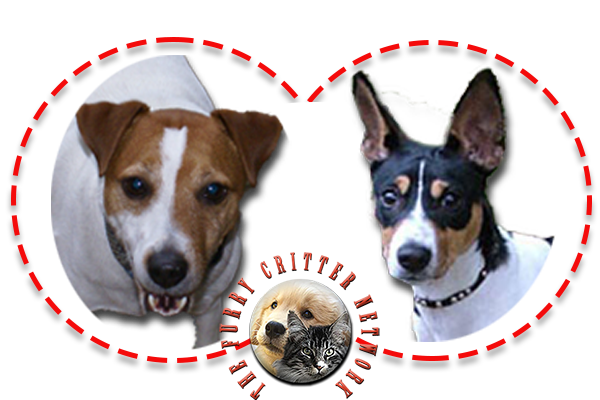Jack Russell Terrier Breed Description - Cross #1
The JRTCA was founded in 1976 by Mrs. Ailsa Crawford, one of the first Jack Russell Terrier breeders in the United States. Ms. Crawford and the early founders of the Jack Russell Terrier Club put a lot of thought into structuring the JRTCA so that work remained front and center.
Towards that end, the club decided that its highest award — the “Bronze Medallion” — would not go to show dogs, but to working dogs that had demonstrated their ability in the field by working at least three of six types of American quarry — red fox, Gray fox, raccoon, groundhog, opossum, or badger in front of a JRTCA-certified field judge. In the show ring the Jack Russell Terrier Club of America decided to ban professional handlers as it was thought this would make the shows less serious (and more fun) while keeping the focus on the essential element of work.
Instead of mandating the kind of narrow conformation ranges demanded by the American Kennel Club for their terrier breeds, the JRTCA decided to divide the diverse world of the Jack Russell Terrier into three coat types (smooth, broken and rough), and two sizes (10 inches tall to 12.5 inches tall, and 12.5 inches tall to 15 inches tall).“Different horses for different courses” became the watchword, with overt recognition that different quarry, different earths, and different climates required different dogs.
Unlike the Kennel Club, the Jack Russell Terrier Club of America also decided to maintain an “open” registry so that new blood might be infused at times. At the same time, the JRTCA discouraged inbreeding and eventually restricted line breeding to a set percentage. To balance off an open-registry with the desire to keep Jack Russell-type dogs looking like Jack Russells, the JRTCA decided not to allow dogs to be registered at birth or to register entire litters. Instead, each adult dog would be photographed from both sides and the front, with each dog admitted to the registry on its own merit. In addition, each dog had to be measured for height and chest span. This last element turned out to be quite important, as it meant that the height and chest measurements of adult dogs were recorded as they were registered. Over time, both height and chest size of adult dogs could be tracked through pedigrees — an essential element of breeding correctly sized working terriers. The JRTCA was not shy about their rationale for these rules: they openly and emphatically opposed Kennel Club registration, maintaining that time had shown that dogs brought into the Kennel Club quickly grew too big and often lost other essential working attributes such as nose, voice, and prey drive.
The Jack Russell Terrier is bred to conform to a conformation show standard. Unlike its close relative, the Parson Russell Terrier, Jack Russell Terriers have noticeably longer legs that are about as tall as the length of the Terrier's body. It is a predominantly white breed with black, tan or tricolor markings and an easy to groom coat which is either smooth or broken (similar to a smooth coat, but with some longer hair on the head, face, legs or body). The breed standard does not recognise a Parson Russell with a curly or rough coat. There is a clear outline with only a hint of eyebrows and beard should the dog be broken coated. They possess moderately thick small "V" shaped drop ears with the tip pointed towards the eyes. The nose of the dog should be black. The normal range of sizes is between 13–14 inches (33–36 cm) tall at the withers, with a weight around 13–17 pounds (5.9–7.7 kg).
The Parson Russell has a relatively square outline, with a body about as long as the dog is tall. Compared to the Jack Russell Terrier the Parson Russell has a longer head and a larger chest along with overall a slightly larger body size. The Parson retains the flat skull but not the elongated shape of the Fox Terrier, and with lower set ears. In addition, the Jack Russell Terrier has a greater variation in size, ranging between 10–15 inches (25–38 cm) in height at the withers. Two hands should be able to span the chest of the dog behind its elbows, with the thumbs at the withers. This is required in show judging, with the judge lifting the dog's front legs gently off the ground in this motion in order to measure the size of the chest. The judges fingers should meet under the chest and the thumbs on top of the spine. The American Kennel Club describes this as a "significant factor and a critical part of the judging process." It is not done to measure the size of the chest, but rather to feel for the correct shape.
Under the show standard, there are several physical points which would be treated as faults in the show ring. These are for the height of the dog at the withers to be outside of the standard range, or for the dog to possess either pricked up ears, a liver or brown colored nose, an overshot or undershot jawline or to have brindle markings.
The AKC used to recognize the Jack Russell Terrier however as of April 1, 2003 they changed the name to Parson Russell Terrier. The breed split into two breeds and now the Jack Russell Terrier and Parson Russell Terrier are considered two different breeds. The Parson's name change is in great part to a lawsuit from the JRTCA to the AKC, when the breed was first allowed registration.






